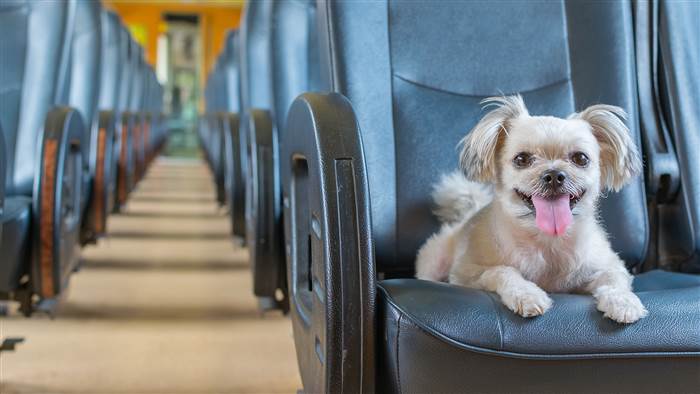22 Signs Your Dog Is Angry With You (And What You Can Do About It)
You may think your dog is just having an off day—but what if they’re actually angry with you? Unlike humans, dogs don’t slam doors or shout when they’re upset.
Instead, they give subtle (and sometimes not-so-subtle) clues that something’s wrong. Maybe you skipped their walk, changed the routine, or raised your voice without realizing how much it hurt.
Dogs are deeply emotional creatures, and when their trust wavers, they’ll let you know. Understanding the signs of doggy displeasure can help you fix the problem before it damages your bond.
Whether it’s a cold shoulder or a chewed-up shoe, every behavior has meaning. Here are 22 signs your dog may be mad at you—and what you can do to make things right.
1. Avoiding Eye Contact
Your pup’s eyes usually sparkle when they see you, but when those bright eyes refuse to meet yours, it might mean they’re upset. Avoiding eye contact can be their way of saying they’re not pleased with something. It’s essential to approach this with understanding.
Offer gentle reassurance without forcing interaction. Rebuilding trust through a calm presence, soft-spoken words, and positive reinforcement can help mend the rift. It’s about showing them they are safe and loved.
Gradually, with patience, your furry friend will likely resume those loving gazes. Dogs, much like people, need to feel understood and valued, not pressured.
2. Turning Their Back on You
When your dog’s back is the only view you see, it might seem a bit cold. This act often signals discontent or a need for space. Rather than taking it to heart, use this as an opportunity to understand their boundaries.
Respect their need for distance, and approach them with patience and a soothing voice. Sometimes, giving them the space they crave can be the most loving gesture of all.
Over time, as they feel more at ease, they may turn back towards you, ready for affection and companionship. Dogs, just like us, occasionally need their personal bubble.
3. Refusing Treats or Food
Your dog’s refusal of treats or food can feel like a personal snub, especially when it involves their favorites. This might be their way of voicing disapproval or stress. It’s important to assess the situation, considering any changes in their environment.
Offering their preferred snacks in a peaceful setting can encourage them to eat. The aim is to minimize stress triggers and create a comforting atmosphere.
Recognize that dogs have their off days too. By being observant and empathetic, you can help your pet feel better and more willing to indulge in their meals.
4. Ignoring Commands They Normally Obey
When your dog starts ignoring commands they usually follow, it can be frustrating. This behavior might indicate confusion, stress, or simply a bit of rebellion. It’s crucial to stay calm and reinforce training positively.
Evaluate any possible sources of frustration or distraction. Consistency and patience are key here.
Using rewards and praise when they do respond can gradually restore their willingness to cooperate. Remember, dogs, like us, sometimes have their moments of stubbornness.
5. Leaving the Room When You Enter
If your dog leaves the room as soon as you enter, it might sting a little. However, this could be their way of expressing unease or needing time alone. Rather than chasing after them, allow them to come back on their own terms.
Use gentle reintroduction techniques, avoiding forceful affection. Sometimes, just being in the same space without interaction can gradually rebuild comfort.
Over time, they may return to being your shadow, eager for your presence. Dogs need the assurance that their space and feelings are respected.
6. Low Growling or Huffing
Hearing your dog growl or huff at you can be unsettling. This low, rumbling sound often signifies discomfort or displeasure. Stay calm and composed, avoiding any negative reaction.
Remove possible stressors from the environment and observe their body language closely. Understanding what triggers these sounds is vital.
Offering a peaceful atmosphere and respecting their space can help alleviate their distress. Dogs communicate their emotions in various ways; patience and attentiveness are key to resolving such issues.
7. Excessive Paw Licking or Grooming
If your dog starts licking their paws excessively, it could be a sign of stress or anxiety. This behavior might indicate that they’re trying to cope with something bothering them.
First, rule out health issues with a vet visit. Then, focus on restoring their routine and providing emotional safety.
Engage them with activities that distract and comfort. Dogs benefit from stability and reassurance, much like their human counterparts.
8. Chewing Up Something of Yours
Coming home to find your belongings chewed up is never pleasant. This destructive behavior might be an expression of frustration or boredom. It’s important to redirect this energy into positive outlets.
Provide them with engaging chew toys and increase mental stimulation through games and attention.
A tired, mentally satisfied dog is less likely to chew on things they shouldn’t. Give them proper outlets to express their natural urges.
9. Peeing Inside Despite Being House-Trained
Finding a puddle inside from a house-trained dog can be both puzzling and frustrating. This behavior might indicate stress, anxiety, or a change in routine.
It’s essential to rule out medical problems first. Once health issues are eliminated, focus on consistency in their routine without resorting to punishment.
A calm, understanding approach reassures them that their environment is safe and stable. Dogs need consistent guidance to feel secure and at ease.
10. Avoiding Cuddles or Physical Touch
When your canine avoids cuddles, it can feel like a personal rejection. Dogs, much like people, have their moods and boundaries. If they’re steering clear of physical touch, it’s best to respect their space.
Allow them the autonomy to initiate contact. When they do seek affection, reward them with gentle praise and petting.
This patient, respectful approach reassures them that their feelings are valued. Over time, they may become more open to snuggles and affection.
11. Ears Pinned Back When You Approach
Ears pinned back often indicate a mixture of fear or submission. If your dog shows this sign, it’s crucial to approach gently.
Avoid eye-level confrontation and speak softly to reassure them. This behavior suggests they might be feeling threatened or anxious.
By creating a calm and comfortable environment, you can help them feel secure. Dogs respond well to gentle, consistent interactions that build their confidence and trust.
12. Tail Tucked Between Legs Around You
A dog with its tail tucked tight between its legs is often exhibiting fear or insecurity. This gesture is a cry for reassurance and care.
Work on building their confidence by avoiding scolding and providing positive reinforcement. Create an environment where they feel safe and supported.
Through patience and understanding, you can help them elevate their tail with pride. Dogs thrive in environments where they feel nurtured and respected.
13. Sudden Barking When You Move or Talk
Unprovoked barking can catch you off guard, especially if your dog is usually calm. This might be their way of expressing surprise or stress when you move or speak.
Try lowering your energy to create a more peaceful atmosphere. Consistently providing a calm environment can gradually reduce this behavior.
Dogs need to feel that their environment is predictable and stable to truly relax and trust.
14. Whining When You Come Close
Whining can be a dog’s way of signaling discomfort or anxiety when you come close. This sound might indicate they are feeling threatened or uneasy.
Show them you’re non-threatening by approaching slowly and giving comfort when invited. Allow them to set the pace of interaction.
Over time, with gentle reassurance, they may become more accepting of your closeness. Dogs need to feel secure in their interactions to build trust.
15. Snapping at You During Play
A playful snap can be startling and misunderstood. Sometimes, dogs don’t know their own strength or boundaries during playtime.
If this happens, immediate cessation of play is needed. Give them a break and calmly teach them better boundaries through positive reinforcement.
Dogs thrive on structured, enjoyable interactions where they feel safe and understood.
16. Refusing to Sleep in Their Usual Spot Near You
When your dog suddenly abandons their usual sleeping spot near you, it can feel bewildering. This shift might be their way of expressing discomfort or dissatisfaction.
Offer comfort items like blankets or toys to re-establish a sense of home. Spend time in their favorite spots to encourage closeness.
With patience, they may return to their cozy nook by your side. Dogs cherish a warm, inviting space that feels like their own.
17. Sudden Interest in One Person Over You
Your dog suddenly showing interest in someone else can sting. It might indicate a shift in dynamics or a need for variety in their social interactions.
Spend quality one-on-one time to rebuild the bond and remind them of your connection.
Consistency in affection and activities helps reinforce your special relationship. Dogs, like us, enjoy diverse interactions but also value familiarity and love.
18. Walking Ahead or Away on Walks
When your dog walks ahead or away from you, it might feel like a power struggle. This behavior can indicate a desire for independence or a lack of focus.
Reinforce leash manners through positive training and use the walk as a bonding experience.
Balancing freedom and guidance allows dogs to enjoy their explorations while staying connected to you.
19. Lip Licking or Yawning When You Talk to Them
Lip licking or yawning when you talk to your dog can be signs of stress or discomfort. These subtle signals indicate they might be feeling uneasy.
Respect their discomfort and ease into reengagement at their pace. Providing a calm, reassuring environment can help alleviate their anxiety.
With time, you can nurture a more relaxed and trusting interaction. Dogs appreciate when their non-verbal cues are understood and respected.
20. Bringing Toys to Others but Not You
If your dog starts bringing toys to others but not to you, it can feel like a snub. This behavior might indicate they’re seeking varied interactions or are feeling a shift in attention.
Create positive associations with playtime together by engaging them with their favorite activities.
Encourage them to include you in their play and reward them for doing so. Building these playful bonds strengthens your connection.
21. Refusing to Make Physical Contact
When your dog avoids making physical contact, it can leave you feeling distant. It’s not uncommon for dogs to need their space.
Sit quietly near them and let them come to you on their own terms. This approach respects their autonomy and shows you value their comfort.
Over time, they’ll likely appreciate the patience and return to seeking your touch. Dogs thrive when they know they can control their social interactions.
22. Sudden Shift in Behavior After a Specific Incident
A sudden behavioral shift following a specific incident can be puzzling. Reflect on what may have occurred and how it might have affected them.
Work to rebuild trust slowly and consistently by creating a safe and reassuring environment.
Patience and understanding are key in helping them regain confidence. Dogs, much like humans, need time to process and recover from unsettling experiences.



























